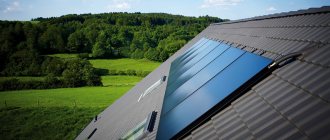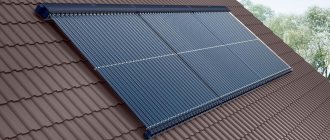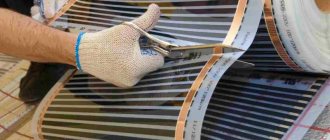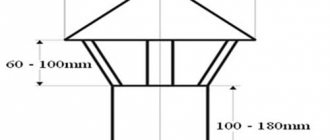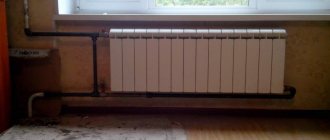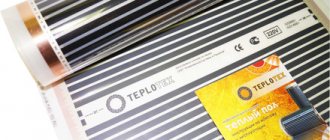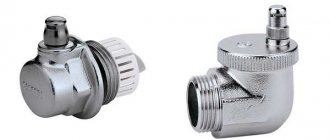To determine the approximate number of solar modules, assume that a family of four lives in a house. It consumes about 3000 kW of electricity per year (this is confirmed by average data). Based on this, a 5 kW photo battery is selected.
Required number of photocell cells
In single-family houses, polycrystalline panels with a power of 240-260 W are most often used (they are characterized by a relatively high efficiency of 18%, and their price is not high). If you choose 250W modules, you will need 20 solar panels, which take up about 35 m2 of roof area.
Attention! Roof panels should be positioned so that they are not obscured by a chimney, tall tree, electrical tower or adjacent building. This may cause overheating and damage to the module.
Therefore, manufacturers equip their panels with shunt diodes (from one to four). When one row of cells is shaded, the diode starts to work, then current flows using a bypass (English bypass - backup path, backup route to ensure continuous operation of the system).
Typical reviews
They can be divided into two groups: reviews of those who already use these devices and the opinions of everyone who is just studying the issue of autonomous power supply.
Most solar plant owners are satisfied with their choice. Having equipped their country house with them, they note the reliability, all-season use and efficiency of solar panels. Those thinking about purchasing express doubts about the economic feasibility, fearing the long payback period of the equipment.
We will express our thoughts on this topic. Taking into account the stable increase in the cost of electricity obtained from external networks, the use of a solar station cannot be called unprofitable. If we are talking about areas where power supply is completely absent or is characterized by frequent outages, then a solar power station is the only option.
Price Costs of Photovoltaic Panels
Material prices are approximate because the cost of panels, inverter or mounting structure is greatly influenced by the type of devices selected, brand and manufacturer. Since most devices are imported from abroad, the current dollar exchange rate is also important.
Example of a list of materials for a 5 kW photovoltaic installation:
- Photocell system consisting of 20 250 W modules – 200,000 rubles;
- Fastening of aluminum profiles on a sloping roof covered with tiles - 50,000 rubles;
- An inverter that allows you to control the installation - 50,000 rubles;
- Connectors and fuses - 10,000 rubles.
- Installation of solar panels takes up to 5 days, for which we will pay the craftsmen 100,000 rubles;
Attention! This specification does not include the cost of batteries as they are an optional option in a solar power plant. An independent installation for a home, due to the need to store electricity, a different type of inverter and slightly more panels, will be 40% more expensive.
In autumn and winter, on cloudy days, the efficiency of a photovoltaic system decreases by approximately 50%.
Useful: Replacing an electrical outlet in an apartment with your own hands
Correct installation
The connection diagram for solar panels is much more complex than the centralized input of the city network. A home power plant consists of at least four elements.
We do not consider primitive 12-volt garden path lighting systems. We will talk about a full power supply of 220 volts.
- Actually photocells. We have already discussed the operating principle and selection criteria. Power calculations are made from a base figure of 5 kW per 1 house. This is approximately 20–40 standard panels with an area of 0.5 m².
- Control unit (controller). Without it, your power plant cannot function. How to choose the right charge controller for a solar battery? It must maintain the overall power of the power supply system, ensure the batteries are charged and correctly distribute the power flow with simultaneous consumption and charging. In addition, the controller is responsible for the safety of the system, including fire safety. The device can be included in the power station kit or purchased separately.
The functionality of all models is standard. When choosing, you determine the power, voltage (12 or 24) and the main criterion - service life (warranty). If the controller fails, your power supply is determined by the capacity of the batteries (until they are discharged). - Battery module. Perhaps the second most important element in the “power plant”. It serves as a storage buffer for the power system. In fact, power is taken from the batteries. Solar cells only restore the supplied energy reserve (charge the battery). Of course, there may be periods when part of the load falls on the solar cells (if the energy generated is significantly higher than the charging costs). Then we can say that your TV or refrigerator is powered directly by the sun. Before installing solar panels, it is necessary to calculate the battery capacity. This is done simply: with an input power of 3 kW, the current consumption does not exceed 15 A (in a 220 volt network). At the output of 12 volt batteries, the current will be already 250 A (in accordance with Ohm’s law). Of course, such power is not taken out constantly, but for the sake of example in the calculations we will take these figures. That is, if you install 5 batteries with a capacity of 100 Ah each, then with such a load the charge will end in 2 hours. Of course, these are conditional figures: in reality, there are many corrections in the calculations. But the base current and power are calculated precisely according to this principle. There are various batteries: acid, alkaline, gel... By and large, there is no point in chasing the most “advanced” systems. And you can only save on the possibility of maintenance: batteries that require supervision are cheaper.
- Voltage transformer. You can take power directly from the battery if your consumers are designed for 12 volt power. However, most electrical appliances are designed for 220 volts. Therefore, a 12–220V converter is installed at the output.
Your internal electrical network is connected to it.
How much can we save on a photovoltaic battery?
Considering the significant investment in a photovoltaic installation, we are interested in how much we will gain in price from its implementation. Assuming that a 5-kilowatt mini-power plant will be installed in a house located in central Russia and will generate 4,500 kWh of electricity per year. This corresponds to the average electricity demand for a family of four.
Therefore, if we pay 6 rubles. per kW/h, we will save about 20,000 rubles. This provides reimbursement after approximately 12 years.
This calculation applies to current prices (as of early 2022) and current regulations. It is difficult to predict how things will change in the near and distant future.
Installing solar panels on the roof
Photovoltaic panels on the sloping roof are laid on aluminum profiles. They are attached to the roof structure depending on the type of covering with appropriate fastening elements. Next, we will show the installation of solar panels on a roof covered with ceramic tiles. This type of material is one of the most frequently chosen by investors.
In addition to the solar cells and profile design, other components of the solar installation are located at home. The most important of them is the inverter and protection unit.
TOP 3: “Optimal dacha”
Review
One of the most popular solar power plants for country houses and country houses, which provides comfortable living even far from urban civilization.
The power of the power plant is 4000 kW, which allows you to connect almost all the devices needed for a summer holiday.
Advantages
- Use all year round;
- Full automation, i.e. switching to sleep mode when the load drops below 5 W;
- Possibility of introducing a reserve in automatic mode (charger, automatic transfer switch, UPS) and charger in winter;
- Stable operation even in bad weather;
- Quiet operation and simple controls;
- Modern interface and quick installation (up to 6 hours);
- Light weight – 25 kg;
- Compact and long service life – up to 25 years.
Technical and operational indicators
- Inverter power – 2400 and 6000 W (nominal and at start-up);
- Efficiency -93%;
- Polycrystalline silicon modules;
- Total power - 600 W (150x4);
- Maintenance-free battery type – GEL;
- Controller efficiency -98%;
- Module weight and dimensions -12.2 kg (1482x674x35 mm;
- Battery weight and dimensions – 65 kg (218×238×522 mm);
- The control unit weighs 20 kg (650×300×150 mm);
- Output voltage -230 V, pure sine wave;
- Charging current -30A;
- Control – PC or display.
Buy
| Where can I buy | Price in rubles |
| https://moskva.tiu.ru/p339887387-solnechnaya-elektrostantsiya-optimalnaya;all.html?_openstat=tiu_prosale%3B%D1%81%D0%BE%D0%BB%D0%BD%D0%B5%D1% 87%D0%BD%D1%8B%D0%B5+%D1%8D%D0%BB%D0%B5%D0%BA%D1%82%D1%80%D0%BE%D1%81%D1%82% D0%B0%D0%BD%D1%86%D0%B8%D0%B8%3B%D0%A1%D0%BE%D0%BB%D0%BD%D0%B5%D1%87%D0%BD% D0%B0%D1%8F+%D1%8D%D0%BB%D0%B5%D0%BA%D1%82%D1%80%D0%BE%D1%81%D1%82%D0%B0%D0% BD%D1%86%D0%B8%D1%8F+%C2%AB+%D0%9E%D0%BF%D1%82%D0%B8%D0%BC%D0%B0%D0%BB%D1%8C% D0%BD%D0%B0%D1%8F+%D0%B4%D0%B0%D1%87%D0%B0%C2%BB%3Bcatalog | 139000 |
| https://ecovolt.ru/catalog/solnechnye_komplekty_stacionarnye/solnechnaya_elektrostantsiya_eko_optimalnaya_dacha_kruglosutochnogo_ispolzovaniya/ | 139000 |
| https://itanna.ru/komplekt-solnechnykh-batarei-dachi-4kvt/ | 139000 |
Where to install the inverter (converter)
Although the location of this device is not critical, it is recommended to place it as close to the panels as possible (i.e. in the attic), which will significantly reduce the loss of current during its transmission. The inverter is usually equipped with a display on which all parameters of the operating installation can be read. Increasingly, manufacturers are providing wireless Internet connections, so it will likely be possible to control the system using a computer.
Choosing the right inverter model depends on the type of solar panels and wiring installed in the house - some devices are used in single-phase networks, others in three-phase.
Types of alternative energy sources:
- Monocrystalline.
Maximum efficiency – 25%. The corners of such panels are slightly beveled. The devices have a characteristic black color. Their front side should always face the sun. If the sun suddenly hides behind a cloud, current production will decrease significantly. The main advantage of monocrystalline batteries is maximum performance, but the disadvantage is the rather high price. - Polycrystalline.
Models are square or rectangular in shape, most often in dark blue. The device consists of inclusions of heterogeneous silicon crystals. The efficiency is about 18%, but energy generation is possible even in cloudy weather, which is incredibly important in areas where diffuse sunlight predominates. - Amorphous.
The cheapest option and there are reasons for that. Their efficiency is only 6%. Service life is no more than two years. The design of such batteries consists of layers of plastic, glass or foil, onto which silicon is very thinly deposited. They burn out quite quickly, thereby significantly reducing work efficiency.
Fuses and connectors
The fuse is located in the main distribution panel, that is, on the electrical panel. It protects the inverter from damage.
In addition, the system has a disconnect switch, which is designed to disconnect the home installation from the external power supply, for example when it is damaged or some maintenance work is being carried out.
Attention! Installation with solar panels must be connected to the network by an authorized electrician. You cannot install such devices into the electrical network without permission - there may be fines, so be sure to invite a local electrician.
Criterias of choice
The only criterion when designing a home power plant and choosing equipment for it should be feasibility.
However, this concept is broad; understanding it will require taking into account many factors:
- Average and maximum power consumption.
- Performance of solar modules.
- Availability of a stationary electrical network and mode of operation together with it.
- Geographical location of the area and climatic conditions.
- Financial capabilities of the home owner.


